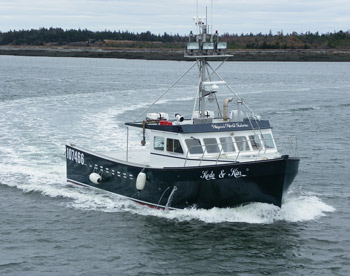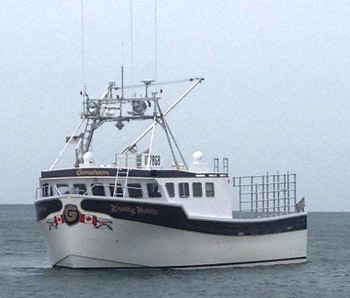The Grand Manan Lobster Fishery
by Sandra Dinsmore

Kode & Kin: 50 X 20 X 6. Grand Manan Boats in Grand Manan, New Brunswick, CA finished this Dixon Marine Group boat in 2012. The MTU 1200 HP runs it up to a top speed of 22 knots. grandmananboats@nb.aibn.com
Grand Manan Island, off Cutler and Lubec, is the largest of the islands in the Bay of Fundy. That means fishing those Grand Manan Fundy waters, although rich in lobster, has to be as difficult as fishing off Cutler and Lubec. Cutler fisherman John Drouin, 50, thinks both fisheries are the same. Both way downeast Maine and Grand Manan fishermen fish for lobsters in very strong tides. “The difference,” Drouin said, “is the weather. Winter weather is fierce down this way on top of the tides.” Difficult fishing or not, Duane Tate, 52, co-owner of Grand Manan Boats, said, “The lobster fishery and aquaculture [salmon farming] are the two big industries on Grand Manan right now.”
Grand Manan was first permanently settled in 1784. Fishermen first set out in rowboats and hauled by hand close to shore so they didn’t have to deal with a lot of tide. Greg Thompson, of Dipper Harbor, NB, who fishes in the Bay of Fundy’s LFA 35, said, “As things moved along, we got trap haulers, which allowed fishermen to go to deeper and deeper water.”
Around 1905, brothers Roy and Herman Doucette, of Cape St. Mary, Nova Scotia, started building Cape Island-style inshore fishing boats. Many Grand Manan fishermen bought the Doucettes’ boats. They were shallow with a long, flat run on the waterline, a raised sheer, bold cabin, and low freeboard from amidships aft.
Otis Green, now 92 and a former owner of Grand Manan Boats, recalled that his father’s first lobsterboat was a Doucette brothers boat. Green’s father brought the boat across the Bay of Fundy from Tiverton, Nova Scotia, to Grand Manan at age 16, thanks to five years of fishing experience. Green said, “He had a little boat compared with what we have today, but it was a big boat at the time. It was a 38-footer.” Ever since, Grand Manan lobsterboats have been growing larger and larger.
At the time of Green’s father’s 38—it was 1914—they had 42-footers along with some 36s and 38s. The 42-footers had a beam of 14 feet, and this balance of the width being a third of the length proved effective.
Green said, “In the days when we had the 42s, Maine fishermen had 26s and 28s because they fished a shorter season in the summertime and they fished closer to home.”
Green also recalled that during the Depression boats were powered with automobile engines. These were not the new, marine engines that power today’s racing lobsterboats; they were engines that came out of Eastport and Lubec junkyards.
Millionaires, once the Depression took hold, didn’t have enough money to fill the tanks of their fancy cars, Green said, so off the cars went to the junkyard.
Green remembers a fisherman coming back from an Eastport junkyard in the early 1930s with an engine he’d bought. Asked what he paid for it, the fisherman said he’d paid $35. “Thirty-five dollars!” the questioner exclaimed. “You can get all the engine you want for $25.” New Packard straight-eight cylinder cars sold for $4,200 in 1928.
“At the time,” Green said, “a big catch for our boats would be 500 pounds a day. We had two seasons: Our main season went from Nov. 15 to just after New Year’s. Then we had a second season that went from January to June.”
Boats started to get bigger in the 1950s, according to Green. He said, “One fellow had a 48- or 50-foot boat built. The locals called it ‘the Wooden World.’ But all the boats were gradually getting bigger: The 42s became 44s, and the first thing you knew, there was a 46. A few years later there was a 48, and that was about as big as a trap boat got.” Green said, “Forty-five was a real good size. Some did go to 46 or 47. It was overkill, but they went there anyway.”
When fiberglass came in, in the 1960s, Green said those boats were bigger than the wooden ones. But the catches and boats of today are an entirely different story.
Tate reported, “On the large end, boats 50 feet long plus a five-foot extension are from 20 to 26 or 28 feet wide. A boat in that range has probably got an 8-foot draft, and there could be another six feet of rail height above the waterline, plus another six feet to the top of the wheelhouse.” But there are only a few boats of that size. “There are more 45-footers,” Tate said. “Their average draft would probably be in the 5-foot range and between four and five feet of rail height.” He added that the height to the top of the wheelhouse above the rail could be another five to six feet.

Knotty Habits, a Dixon Marine Group 50 X 27 X 6.5 boat fishes at Grand Manan. It has 5 live wells with a 120-crate capacity. It runs a 13.5 John Deere. Dixon Marine Group photo
There are also a few of the smaller inshore lobsterboats. Tate said these are probably from 38 to 45 feet long with a draft of anywhere from three to five feet. Beam is generally between 16 and 20 feet.
But not all Grand Manan fishermen have huge boats. Drouin said most of them fish under the same conditions as downeast Maine fishermen. When Drouin fished off Machias Seal Island all year from 1990 to 2002, he started with a 36-foot fiberglass Novi. Then in 1994 he switched to a Jonesport Wayne Beal 36. In 2002, he bought his first Wesmac, a 42-footer. He then moved up to a Wesmac 46 and is presently having another Wesmac 46 built three feet wider than his previous one.
“Twenty years ago,” Drouin said, “a 40- to 45-foot boat was huge. Now that’s average or even small.” Yarmouth, Nova Scotia, lobster fisherman Ashton Spinney agrees. He fishes from a boat that’s 44 feet 9 inches long with a 20-foot beam. He said, “I could put a five-foot extension on her, but I haven’t,” he said of his boat. “It’s on the small side.” He explained, “They’re talking 44 with a five-foot extension, 27-foot wide, and high-sided. The height and width enable the boats to have large live wells, and the fishermen can stay out multiple nights. The product is in excellent shape when they come in.”
Tate said simply, “The boats have adapted to the fishery.” Catches of over 200 crates, as happened in November on Opening Day, are one reason why fishermen need bigger boats.
Many boats under construction and even some of the older boats, Tate said, are putting in live wells so they can keep their catch fresh. “The 50-footer we built was 20 feet wide,” he said. “It had the capacity to put 50 crates below deck in the live well.”
The boat that held those 210 crates was a 50-footer with the usual five-foot extension and is 22 feet wide. “Believe me,” Tate said, “If they’re catching lobsters, they’re going to find room for them. They have other cargo areas below deck other than the live well. There’s a fish hold there as well that’s not necessarily dedicated to the lobster catch, and there’s a lazarette, which is the storage compartment at the stern of the boat.” He said, “Sometimes if they run out of crates, they’ll make a pen and they’ll pile them up in a corner. There’s always a way to hold the product.”
But these massive boats, much wider and taller than Maine lobsterboats—some of the 45-footers and many of those in the 50-foot range (both with that five-foot extension)—have engine rooms big enough to stand up in. Fishermen can walk around their engines, which, of course, is helpful for working on them. But it wasn’t always that way. Tate recalled, “Back in the 1970s engine compartments in those wooden boats were not real accessible.” He said the floor around the engine was removable so as to get access. “Now,” he said, “everything is below floor level. They’re down there standing up and they have all kinds of room to work. The boats have grown in such a way that they need ladders to get into the engine room now.” Maine fishermen usually have to sit to work on their engines.
A friend of Green’s has a new engine in his machine shop that cost a quarter of a million dollars. “Along with that,” Green said, “the owner has got to have a propeller shaft, propellers, pumps, all the controls. This is just machinery. It doesn’t include the boat!” And it doesn’t include a “gen” set.
“If they’ve got a generator aboard,” Tate said, explaining that the generator supplies onboard AC power, or house current, “it could be a fairly expensive piece of equipment. If you were installing, say, a 16-kilowatt gen set,” Tate went on, “you might be looking at a complete system that might cost in the C$50,000 range. Or more,” Tate added, “because it requires an electrical system of its own. The onboard power on most boats is DC power, and the generator supply is AC power: 120 and 240 volts.”
“We’ve heard some of the builds in Nova Scotia going into the million-dollar category,” Tate reported. “They want them geared up with gen sets and they’ve got television—wide-screen TVs, a full galley. It’s a live-aboard vessel. We find our guys are a little bit more conservative on the build side.” He called the boats Grand Manan Boats build, “basic, plain Jane lobsterboats. Nothing fancy.”
“What they’re looking for now in a lobsterboat is deck space,” reported Tate. He explained that fishermen fish 25-trap trawls. If they want to shift their trawls, he said, “They’ve got 50 traps on deck and they have to have room to work.”
Tate said 50-foot boats could cost C$500,000 or $600,00, depending on the machinery. On the low end, they’re around $300,000. And if you look hard enough you’ll see they still carry the bones of the old Cape Island boats.
